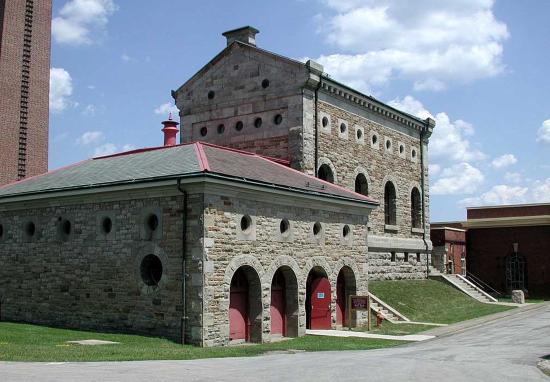Plan a field trip to the Hamilton Steam Museum and use our Self-Guided Field Trip Guide to add some easy education to your entertainment. This school year, classes and students won’t be going on field trips, but that doesn’t mean your kids have to miss out on the hands-on in-person learning that field trips offer. Take them yourself, and use our Field Trip Guide to help encourage additional learning!
Our Self-Guided Field Trip Guides have been created by Amanda, a Peel Region elementary teacher to help families connect education to the entertainment that comes when visiting one of the many local cultural attractions. This issue is the perfect companion to your Hamilton Steam Museum visit.

Hamilton Steam Museum
Visit here when you are studying: Science & Technology:
Witness the social and mechanical life of Canada’s early industrial revolution. Housed in a 160-year-old Waterworks, this National Historic Site preserves two 70-ton steam-powered water pumping engines, perhaps the oldest surviving Canadian-built engines. The historic Hamilton Waterworks is a Civil and Power Engineering Landmark.
Grade 1
Understanding Structures and Mechanisms: Materials, Objects, and Everyday Structures
Investigate structures that are built for a specific purpose to see how their design and materials to suit that purpose; Demonstrate an understanding that objects and structures have observable characteristics and are made from materials with specific properties that determine how they are used.
What does that mean?
Students will be looking at shapes, materials and structures in this unit. What makes a material good for building a specific structure? What shapes help make the structure strong?
Get the kids thinking:
- Try to figure out the purpose of each of the buildings, look at the materials they are made from – why those materials?
- Are the heavy? Light? Strong?
- Find the shapes in the buildings. Triangles are very strong, but buildings are usually square or rectangular. Can you find where they have used triangles to make the building stronger?
Vocabulary: purpose, smooth, solid, rigid, flexible, texture, shape, wood, plastic, steel, paper, foam
Grade 2
Understanding Structures and Mechanisms: Movement
Assess the impact on society and the environment of simple machines and mechanisms; Demonstrate an understanding of movement and ways in which simple machines help to move objects.
What does that mean?
Students will be looking at how simple machines (a lever; an inclined plane; pulley; wheel and axle, including gear; a screw; and a wedge) make tasks easier and how they move.
Get the kids thinking:
- Which simple machines do you see?
- Which way are they moving? How do you think that helps us?
- Are there any ways in which building this machine to help us may also hurt us? (are there environmental impacts of running it? )
Vocabulary: push, pull, beside, above, wheel, axel, inclined plane, pulley, lever, screw, wedge, turning, spinning
Grade 3
Understanding Structures and Mechanisms: Strong and Stable Structures
Assess the importance of form, function, strength, and stability in structures through time; Demonstrate an understanding of the concepts of structure, strength, and stability and the factors that affect them.
What does that mean?
Students will be learning the definitions of strength (the ability to support a load) and stability (the ability to maintain balance and stay fixed in one spot) and investigating the properties of the materials used to make them, as well as how to improve them.
Get the kids thinking:
- What about these buildings mean that they are still standing after so long?
- What materials are they made from?
- What if we made them out of gold? Paper? What would be different?
- Could you do anything to those materials to be able to build something strong like this?
- Find the shapes in the Hamilton Steam Museum buildings. Triangles are very strong, but buildings are usually square or rectangular. Can you find where they have used triangles to make the building stronger?
Vocabulary: compression, tension, strut, ties, strength, stability, flexibility
Grade 4
Understanding Structures and Mechanisms: Pulleys and Gears
Evaluate the impact of pulleys and gears on society and the environment; Demonstrate an understanding of the basic principles and functions of pulley systems and gear systems.
What does that mean?
Students will be learning how pulleys and gears work to make life easier and the change in movement and/or speed that happens in pulley or gear systems.
Get the kids thinking:
- If you can see the engines etc working, try tracing the movement and looking particularly at the gears – which way is this one turning? What about the next one?
- Why do you think there’s a difference in size between them?
- What happens to the speed now? Is there anywhere where one kind of movement is turned into another kind of movement – like rotary to linear – is there a flat gear instead of a wheel?
Vocabulary: pulley, gear, force, speed, spur gears, bevel gears, crown gears, pulley block
Grade 5
Understanding Structures and Mechanisms: Forces Acting on Structures and Mechanisms
Identify forces that act on and within structures and mechanisms, and describe the effects of these forces on structures and mechanisms.
What does that mean?
Students are looking at the forces within structures that help make them strong and the forces around structures acting on them.
Get the kids thinking:
- Where are the forces in the building? Is there anything that adds to that? The people walking on the floors above? The wind from outside?
- Can you see anything in the Hamilton Steam Museum building that makes it stronger to deal with those forces?
Vocabulary: tension, compression, torque, load, weight
Kids are like sponges, and they want to soak up everything they can learn, and all we need to do – as parents and educators – is make it interesting. Take a visit to the Hamilton Steam Museum and “get their gears turning” today!
